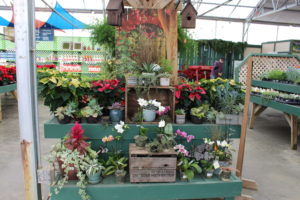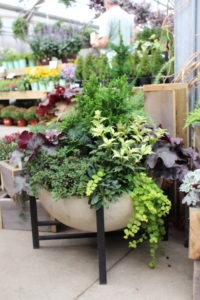The Gardening Gourmet
Traveling around the country (with an occasional international expedition) within the past few years, I have noticed the explosion of gourmet foods in the garden center. Everything from jellies and coffees to dessert mixes and sauces, you name it; it is moving into our industry. Many garden centers just stock a few items here and there, but a number are carrying several hundred square feet of specialty food products, and they are flying off the shelves.
I recently spoke to John Roberts, president of The National Association for the Specialty Food Trade (NASFT) about the specialty foods (gourmet) market and how it relates to garden centers. He said that specialty food buyers come from the upper-middle and higher income brackets, just like most garden center customers. According to Roberts, “The average income of a specialty food household, defined as a heavy buyer of specialty foods, starts at about $70,000, but over $100,000 is where specialty foods folks really kick in.”
With the recent boom of garden center cafés, it just makes sense that you can sell boxes and mixes of the kinds of things you are serving. According to Roberts, “We can identify a group of specialty food products that are 22 billion in manufacturer (shelf stable goods) dollars, which probably means there are about 44 billion in retailer dollars. The entire food industry is roughly $800 billion, that’s including all of the food consumers eat. Roughly half of that is food consumed away from home, and the other half is food consumed at home. If the food consumed at home is $400 billion and specialty food is about $44 billion, you can see that we may be about 10 percent of the market, which is a pretty small part of the action; its why you usually find smaller companies in the business rather than larger manufacturers.”
History
In the 1950s (when the gourmet market really took flight), specialty foods were defined as exotic/ imported items such as caviar, truffles, etc. Ethnic imported foods, which were not necessarily upscale, were remembrances of immigrants’ heritage. Another characteristic of early gourmet food is that it was desired, but not enough to get it into the large outlets.
In the late 70s/early 80s American companies looking at French mustard, English jams and other imported items decided it was time to take matters into their own hands and started developing foods that were just as good as the imported foods. The U.S. companies made the prices more reasonable than the imported foods, so naturally they were well accepted.
However, the thing that really got specialty foods going in the United States was when companies stopped copying the European market and developed distinctly American, upscale items such as salad dressings, salsas, tortilla chips and BBQ sauces. “Even though there were mass-market entities in the states for these items, the higher quality items immediately found a consumer market,” explained Roberts. “First in specialty foods stores like specialty cheese shops and small groceries, but slowly through the 80s and 90s in supermarkets.”
“Then, everyone began studying the specialty food consumer,” continued Roberts. “They asked ‘who are these people, what’s crazy about them that they are buying this expensive food and are willing to pay two and three times as much for the same type of product’. What everyone has figured out is that these consumers are not just upscale in food, they are upscale in everything they do.” Gourmet food households have very little time, so time is more important than money; convenience and quality are more important to them than a few extra dollars.
Price Point
Another perk about gourmet food is that the margin on these products has not been beaten down at the box stores or large supermarkets. Specialty food prices have been protected by relatively low volume; therefore, a garden center can make a reasonable gross profit and not worry about customers saying they can buy the same product cheaper at Wal-Mart or Cosco. The smart garden center can pick the foods they want to stock, offer an array of goods and still make a nice profit.
Choosing Correctly
“What we really need to talk about are products that are higher in quality and still not mass market,” Roberts explained. “They require a little bit of additional attention by the retailer and the consumer because you just can’t sell them anywhere. You have to be careful about what you stock; select your items carefully. You have to know your own customers, and if you do that well you can make a fairly good profit on these products and build a relationship with your clientele because you are the place that stocks them.”
Consumers are looking for products that fit into their lifestyle, making it more convenient to put something exciting on the table. “We find people are looking for adventure; they are looking for fusion food; they are looking for a combination of Thai or Mexican,” said Roberts.
Roberts discourages the belief that there are very hot food categories everyone can stock. Additionally, Roberts asserts that it is very difficult to predict trends in the food industry. Nonetheless, the following are a few guidelines to follow when selecting products.
- New food items tend to come out after world events. Roberts predicts that within the next 2-3 years there will be a heightened interest in the Pacific Rim, African, Muslim, Egyptian, Lebanese, Moroccan and Indonesian foods because of recent events (good or bad) in those countries.
- Another thing is the rule of history repeating itself. Something that was exciting 20 years ago will come back even bigger and better.
- Basing new foods off of new and different types of restaurants. Roberts said a few years after a certain type of restaurant craze the gourmet food people will develop products to complement that cuisine. For example, when Thai food became popular a few years ago, companies started putting Thai sauces on the market for the home gourmet.
Competition
There are some specialty shops that sell gourmet foods, so I asked Roberts what he thought about the idea of garden centers competing in this market. “We regard a garden center that stocks specialty foods as a specialty foods store,” responded Roberts. “The traditional specialty foods store would not see the garden center as a big entity; they would see it as another educator doing specialty foods. They see a lot of garden centers doing it the way they are doing it, with a lot of careful selection and a lot of education. That is what the stores welcome.” Roberts said that many of the specialty foods stores are going to garden centers to get ideas about how their business is run, and they are thinking “should I be stocking some plants, or Á should I be recognizing what the garden center is recognizing that we have a common consumer that has a lot of money and buys a lot of stuff. How should I be expanding my variety of products to make it easier for them to pick up what they usually pick up in garden centers?”
You know your demographic; you know your customers. Gourmet foods may or may not work for you, but come on, who doesn’t love to eat? Just a little food for thought!


















 Videos
Videos





